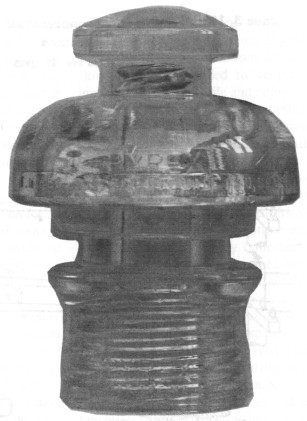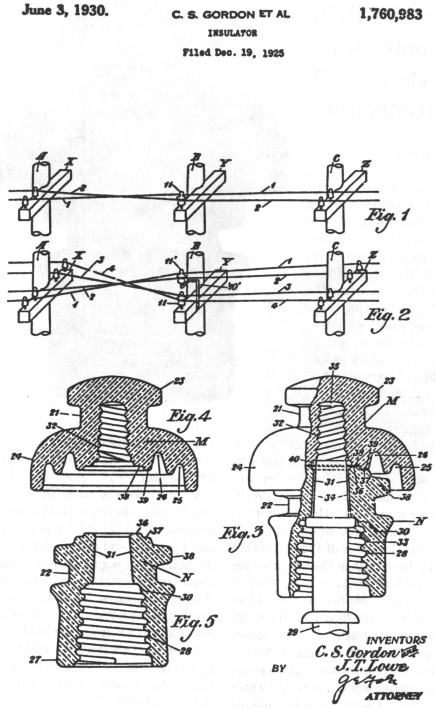The PYREX "Knob Top" Meets Its Bottom Half
by Dan Wagner
Reprinted from "Crown Jewels of the Wire", February 1990, page 5
Here they are. The first photographs of the top and bottom half of CD 194.5
and 195.5 together. Since the first article on the top half, nicknamed the
"knob top", appeared in the November, 1987 issue of Crown Jewels of
the Wire, much has been learned about the insulator including the discovery of
the bottom half of this two piece transposition insulator.

Amazing, if you
consider the odds against such a thing happening. I felt extremely lucky to have
obtained the top half, but now to have the bottom also, it's just.... Well, I
guess I'm in shock! Here is what has happened since November, 1987.
In late
December of 1987 I received a letter from Nathan Holmes, a young collector from
Walcott, Iowa. Nathan pointed out to me that on page 13 of Milholland's 4th
Revision there appears a patent relating to a two-piece transposition. He also
stated that the top half of the insulator in the drawing looked similar to the
"knob top" which had appeared in the Crown Jewels article the preceding
month.
I believe that I brought this to the attention of some insulator people
shortly after Nathan's discovery and I am not certain why so much time passed before contact was made with N.R. "Woody" Woodward about the patent.
Possibly the hectic holiday season and a new baby daughter kept me busy and I
didn't spend as much time with the hobby as I normally would have spent. I did
not make contact with Mr. Woodward because I thought someone else had and that
Woody had decided to not assign a CD. It was not until April, 1989, when I
received a letter from Bill Snell with a complete copy of the patent that I made
contact with Mr. Woodward again.
This was Woody's response to my inquiry:
Would
you believe, the C.S. Gordon patent which you enclosed has been in my rather
extensive patent file for some time. Jack Tod had related it to CD 194-195 in
his patent book; and while I had noted that it didn't match those very closely,
I had filed it away and had no memory of the exact connection. Only much later,
when Elton Gish called it to my attention, was I aware of it.
You are correct,
the drawing does match the insulator exactly, and also explains its purpose.
Although we have no knowledge that it was ever produced in any quantity or
placed in service, we now do know what it was intended to accomplish.
Although I
don't care for assigning numbers to experimental pieces until we know they were
used on the line, I have gone and assigned the top CD 195.5 and if we ever find
the bottom, it will be CD 194.5. Until this patent came to my attention, I had
no idea where to classify it! WOODY
At least, the top had a "name" and only time would tell if there
was a bottom somewhere. Thanks to both Nathan and Bill for their help. Bill also
highlighted the reference to Pyrex glass on Page 3 of the patent:
It has been
found that the commercial form of glass known as Pyrex B has a very low loss angle
and for this reason it is preferred to construct the insulator of this material.
While all of this was going on, Bill Rosato of Elizabethtown, Pennsylvania,
picked up the bottom half at a bottle show in Baltimore, Maryland. Bill didn't
know what it was he had found, but after the word spread that he had something
unusual with a Pyrex embossing on it filtered across the country to me, I called
him and discovered that it was the bottom for the "knob top". Bill
decided to keep the insulator for a little while and enjoy it. He wasn't ready
to sell. Maybe another top would turn up and Bill would have a complete
insulator. I could only wait for a decision from Bill.
Later, at the National in Allentown, an offer was made with the help of Carol McDougald, Bill sold the
insulator, and now the top and bottom are together forever -- in my collection.
Carol did it again. If you remember, Carol was responsible for getting the top
to me two years ago.
I have since spoken to Bill Rosato and he has said that he
has spoken to A.T. & T. Company employees who have told him that there was
an outdoor testing station at Phoenixville, Pennsylvania. Collegeville is just a few miles from that location and it was
in Collegeville where Frank Prinzinger originally found the "knob top"
in 1971. Also, the bottle digger from whom Bill purchased the bottom half told
him he had dug the piece in the same area of Pennsylvania. Bill promised to
continue to research the A.T.& T. testing station and I hope he can turn up
more information concerning the two-piece transpositions.
(EDITOR'S NOTE: The end of the story has an unusual twist...just the other
evening I spoke with a collector who has just located another "knob
top" and is now looking for its mate -- the bottom. The collector who is
biting hard on his first knuckle Is none other that Pennsylvania's once proud
owner of the only Gordon and Lowe bottom piece found to date ---- Bill Rosato!!)

Large Image (177 Kb)
C.S. Gordon and J.T. Lowe Patent of June 3, 1930
| 